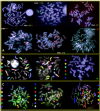Chromosome phylogeny of the subfamily Pitheciinae (Platyrrhini, Primates) by classic cytogenetics and chromosome painting
- PMID: 20565908
- PMCID: PMC2905426
- DOI: 10.1186/1471-2148-10-189
Chromosome phylogeny of the subfamily Pitheciinae (Platyrrhini, Primates) by classic cytogenetics and chromosome painting
Abstract
Background: The New World monkey (Platyrrhini) subfamily Pitheciinae is represented by the genera Pithecia, Chiropotes and Cacajao. In this work we studied the karyotypes of Pithecia irrorata (2n = 48) and Cacajao calvus rubicundus (2n = 45 in males and 2n = 46 in females) by G- and C-banding, NOR staining and chromosome painting using human and Saguinus oedipus whole chromosome probes. The karyotypes of both species were compared with each other and with Chiropotes utahicki (2n = 54) from the literature.
Results: Our results show that members of the Pitheciinae have conserved several chromosome forms found in the inferred ancestral Platyrrhini karyotype (associations of human homologous segments 3a/21, 5/7a, 2b/16b, 8a/18, 14/15a and 10a/16a). Further, the monophyly of this subfamily is supported by three chromosomal synapomorphies (2a/10b, an acrocentric 15/14 and an acrocentric human 19 homolog). In addition, each species presents several autapomorphies. From this data set we established a chromosomal phylogeny of Pitheciinae, resulting in a single most parsimonious tree.
Conclusions: In our chromosomal phylogeny, the genus Pithecia occurred in a more basal position close to the inferred ancestor of Platyrrhini, while C. c. rubicundus and C. utahicki are closely related and are linked by exclusive synapomorphies.
Figures






References
-
- Hershkovitz P. A preliminary taxonomic review of south american berded saki monkeys genus Chiropotes (Cebidae, Platyrrhini), with description of a new subspecies. Fieldiana. 1985;27:1–46. - PubMed
-
- Rosenberger AL. In: Ecology and Behavior of Neotropical Primates. 1. Coimbra-Filho AF, Mittermeier RA, editor. Vol. 1. Academia Brasileira de Ciências; 1981. Systematics: the higher taxa; pp. 9–27.
Publication types
MeSH terms
Substances
LinkOut - more resources
Full Text Sources

